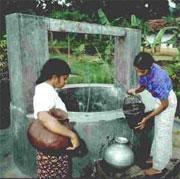 All's well? Much of Sri Lanka's water isn't fit to drink.© FAO
All's well? Much of Sri Lanka's water isn't fit to drink.© FAOThe devastating tsunami of 26 December 2004 is still making itself felt in Sri Lanka; though more than 16 months have passed, the well water in many coastal areas of that country is still undrinkable, a study has found.
The Indian Ocean tsunami, created by an earthquake off the coast of Sumatra, Indonesia, killed more than 25,000 people in Sri Lanka. The flood also destroyed, or contaminated with sea water and pollutants, almost all the wells within reach of the waves, which in places penetrated up to 1.5 kilometres inland. Most of the rural or semi-urban population of Sri Lanka's southern and eastern coastlines rely on groundwater taken from some 40,000 shallow wells, each of which serves several families.
Problems with this well water still persist today, according to a 14-strong team of scientists. The team, including geologists and water engineers from Sri Lanka, the United States and Denmark, began surveying the problem in February 2005. They found that in most places the aquifer, which is normally fed and replenished by monsoon rainfall, shows little, if any, sign of recovery1.
About 67-100% of wells that had been flooded, and 17-50% of those that escaped the floodwaters, were still not suitable for drinking 7 months after the tsunami, notes Karen Villholth of the International Water Management Institute in Colombo, Sri Lanka. Vilhoth is a co-author of the paper, and leads a well recovery initiative in Sri Lanka's Batticaloa and Ampara districts.
"Levels of salinity were still extraordinarily high in September, as was cross-contamination with pesticides and insecticides from upland fields," says Jayantha Obeysekera, a Sri Lanka-born hydrologist at South Florida Water Management District in West Palm Beach. "What makes the situation worse is that there exists no water-control monitoring system," he says.
Here comes the rain
One reason for the continued saltwater contamination is that Sri Lanka received relatively little monsoon rain in the first months after the tsunami. The monsoon was substantial again in December last year. But the researchers say it will take several more monsoon seasons until rainwater will have sufficiently flushed the aquifer in some of the most-affected regions.
Local people's attempts to clean the wells after the flood have sometimes done more harm than good, the team found. Excessive pumping, for example, only allowed more sea water to enter the aquifer from below and caused numerous wells to collapse. Besides, polluted water that was pumped out of wells was often disposed of improperly, allowing contaminants to seep back into the aquifer. Sand mining, and enhanced beach erosion caused by the tsunami, are also adding to the slow rate of recovery, the scientists say.
"It would be unfair to say that the locals or helpers were doing anything wrong," cautions Tissa Illangasekare, a groundwater hydrologist at the Colorado School of Mines in Golden, and lead author of the study. "Given the enormity of the disaster it is no wonder that there was just no sufficient level of preparedness."
Be prepared
Hundreds of thousands of households in Sri Lanka have become accustomed to using clean water trucked in by the government or supplied by various relief organizations. Plans are now underway to pipe water to many coastal villages, and expand centralized sewage collection. However, fights flaring up between Sri Lankan government forces and Tamil separatists could hamper relief efforts in some of the most severely affected villages on the island's east coast.
ADVERTISEMENT
The researchers hope that their study of the hydrogeological impact of the tsunami could be used as a first step towards developing internationally recognized emergency guidelines for many other areas threatened by hurricanes, storm surges and sea-level rise. Illangasekare is now organizing a NATO-funded workshop on water security, which will be held in Croatia in autumn.
"Tsunamis don't happen too often," says Illangasekare. "So when you have the opportunity you should look as closely as possible at the problems that can arise, and try to learn the lessons."
Visit our lankaswaterstillplagued.html">newsblog to read and post comments about this story.
